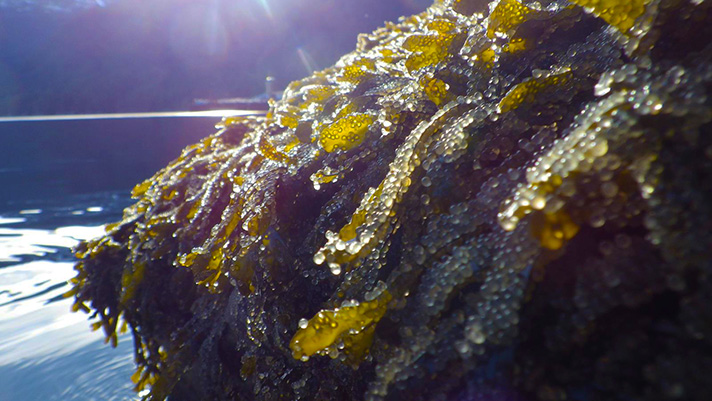Squamish LNG plant cooling system threatens herring
April 17, 2015

Squamish LNG plant cooling system threatens herring, if approved, while the 1991 Federal Guidelines on cooling water intakes is out-dated.
Fisheries and Oceans Canada (DFO) guidelines recommend industrial marine water intake pipes be located at least 2 km from documented herring spawn areas. Local video near Squamish, B.C. documents herring spawn occurred within 2 km of the proposed Woodfibre LNG site in February and March, 2015.
Video: March 2015 herring spawn by John Buchanan
According to federal guidelines, marine intakes can have “severe impacts on marine resources.” The guidelines state herring eggs and larvae are particularly vulnerable.
The proposed project’s Environmental Assessment Application reports the nearest herring spawn occurred 3.5 km across the channel from the proposed Woodfibre LNG site and references DFO monitoring data. However, it’s unclear if herring spawn monitoring has been conducted near the Woodfibre LNG plant in recent years by the proponent or DFO.
“The proposed Woodfibre LNG marine cooling system will put Howe Sound herring and everything that feeds on them at risk,” said Stan Proboszcz, biologist with Propeller Strategy. “It’s unclear whether the proponents looked for herring spawn 2 kms in all directions from the proposed site, and at the appropriate time of year.”
If approved, the proposed LNG plant cooling system would require about 17,000 cubic metres of water be drawn per hour from Howe Sound. The water would be returned to Howe Sound, elevated in temperature. Marine animals, including herring, typically are sucked into marine intakes.
In addition, the DFO guidelines for minimizing loss of animals to marine intakes are 24 years old and out of date:
- They recommend locating marine intakes at a depth greater then 25 metres, but omit research on larval (i.e., baby) herring migrations. Baby Atlantic herring are known to congregate to depths of 40 metres.
- The 1991 guideline explicitly state they are not based on B.C. research on the effects of marine intakes and the local biology. According to the guidelines, no research on this has been done locally.
- In 2010, California adopted new regulations that require energy generating plants to stop using "once-through" cooling systems with marine intakes. The State Water Board says they are “dangerous to marine life” and kill millions of marine animals every year.
In contrast, the proposed Petronas LNG plant in the Skeena River estuary is planning to use an air-cooling system that would side-step the need for a marine intake.
Background Information:
February 2015 herring spawn videos conducted by John Buchanan:
1991 Federal Guidelines for Minimizing Entrainment and Impingement of Aquatic Organisms at Marine Intakes in British Columbia
http://publications.gc.ca/collections/collection_2007/dfo-mpo/Fs97-4-2098E.pdf
Page 3 –Distance Criterion: “Do not site intakes at or near herring spawning areas that show historical spawning over time. Allow a minimum of 2 km between an intake structure and a documented herring spawing area. Distances less than 2 km could pose a serious risk to herring”
Page 4 – Depth Criterion: “Install screened stationary intakes at a minimum depth of 25 m below the zero tide level. This guideline is in addition to not siting marine intakes near sensitive fish larval areas.”
Page 1 – No studies statement: “In British Columbia, no studies on entrainment in seawater intakes have been conducted because the region has no nuclear power plants and few operating marine intakes for other industries.“
Research highlighting depth migrations of Atlantic herring to 40 metres, synopsis:
http://link.springer.com/article/10.1007%2FBF00001025#page-1
Research highlighting not much is known on Pacific herring depth migrations, much of what we know is based on Atlantic herring, page 4:
http://research4d.org/projects/larvamap/Larvamapfinalreport-Appendix2-Pacificherringlarvaltransportmodeling.pdf
California State Water Board phase out of harmful marine intakes:
http://www.swrcb.ca.gov/publications_forms/publications/factsheets/docs/oncethroughcooling.pdf
NOTE: This post was originally published by Propeller Strategy on April 16th.